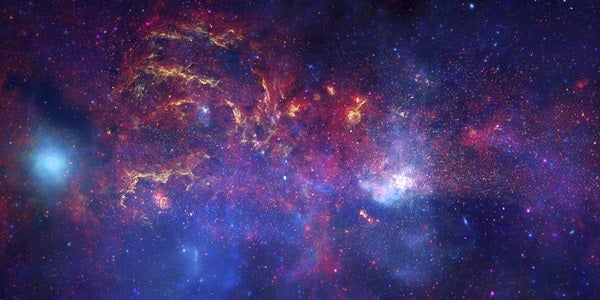To make life, our bodies require many chemicals to have a certain “handedness,” a left or right orientation called chirality that determines the behavior of those substances in our bodies. The requirement is the molecular equivalent of why sticking your left hand onto your right wrist won’t work — despite being mirror images, they are not interchangeable. Chiral molecules are an essential building block of life. They are ubiquitous on Earth and in some comets / asteroids, but scientists have never observed them in interstellar space.
Until now.
Researchers at the National Radio Astronomy Observatory (NRAO), CalTech, and Harvard, working on observations chiefly from the Green Bank Telescope in West Virginia, spotted a chiral molecule in the interstellar dust around Sagittarius B2, a molecular gas cloud in the center of the Milky Way. The results were published today in Science and presented at the 228th meeting of the American Astronomical Society in San Diego.
The researchers found a chiral chemical called propylene oxide, a chain of chemicals with the chemical symbol CH3CHCH2O. There’s a big caveat here: It’s found on Earth but is an alcohol compound toxic to life, used as a fumigant and fuel, and known as a likely carcinogen. It’s organic, but highly volatile.
In other words, it doesn’t necessarily point to a building block for life. What’s important is the chirality, the fact that it demonstrates in space the kind of “handedness” associated with life on Earth. In other words, it’s an indicator that a certain requirement for life exists outside of Earth.
“We can use propylene oxide for a signpost to find handedness in other molecules,” Brandon Carroll, a PhD candidate at Caltech and coauthor of the paper, says.
Brett McGuire, a Jansky postdoctoral fellow at the NRAO, says the chiral molecules likely formed inside a comet or similar icy body, where all those basic ingredients would comingle over long periods of time. A passing jolt of ultraviolet radiation or cosmic rays could then catalyze a reaction in the comet that creates propylene oxide and other organic compounds.
The research is based on three detections, two at Green Bank and one at the Parkes Observatory in Australia, part of NASA’s “Deep Space Network” for communicating with space probes.
The researchers were able to determine whether or not the chemicals were chiral, but not whether or not they had a left or right orientation. That would take an intense amount of research at the largest telescopes in the world like Arecibo, the Very Large Array, and the Atacama Large Millimeter/submillimeter Array, all of which have scarce telescope time (and, in some cases, funding).
“The technology exists to do these measurements, it’s just very, very difficult to detect,” McGuire says. He adds, “we could, in theory, see a small difference in right or left light interacting with propylene oxide.”
Further research is needed to find other “handed” chemicals in interstellar space, but it’s an important step towards understanding the chemistry of the cosmos, and determining the abundance of life-building chemicals in space.
Propylene oxide is “about the smallest chiral molecule that we can think of,” McGuire says. Now they may turn their attention to alanine, the second smallest amino acid after glycine. We just need to know how — and where — to look.
“We’d like to understand chirality just not in one small place in the center of the Milky Way,” Carroll says. “We want to find it elsewhere.”










